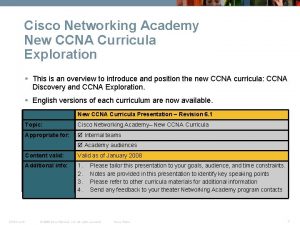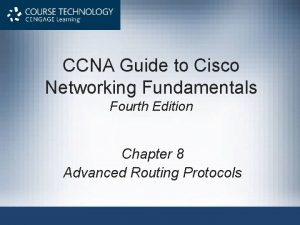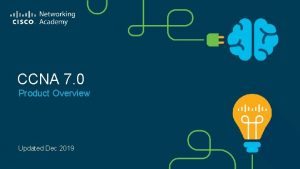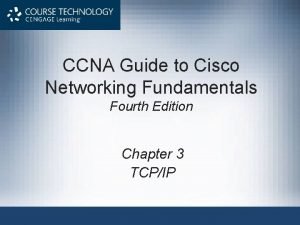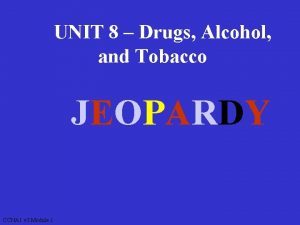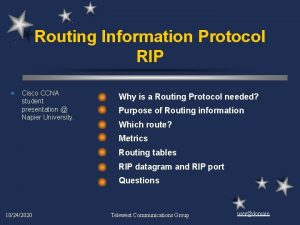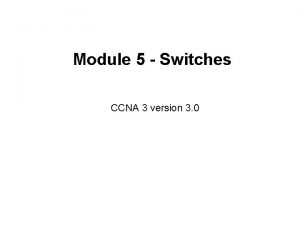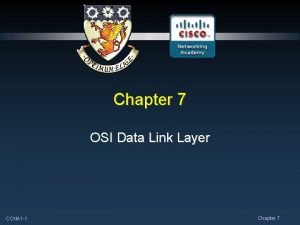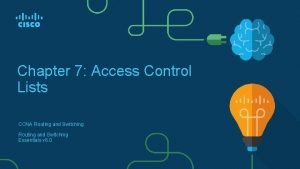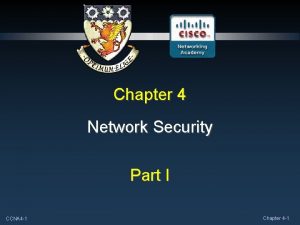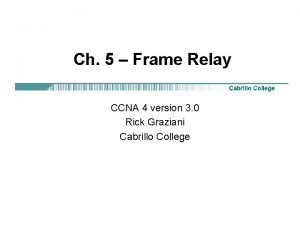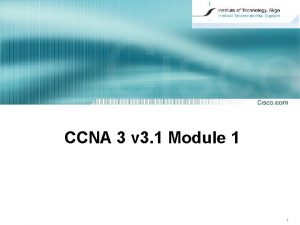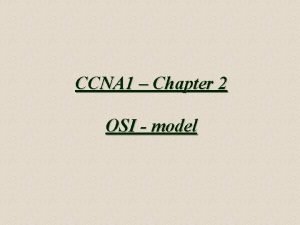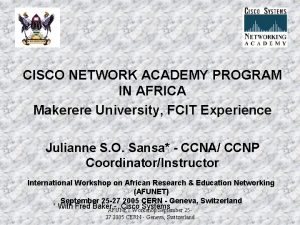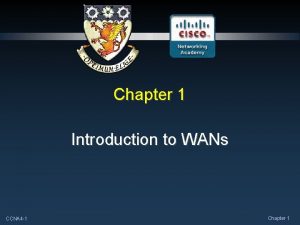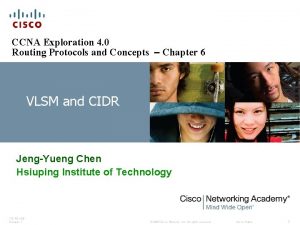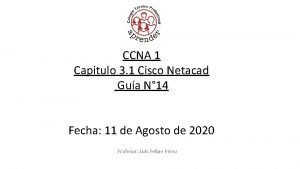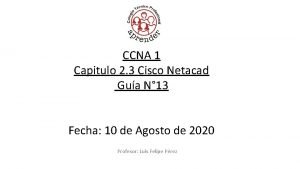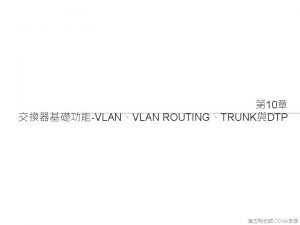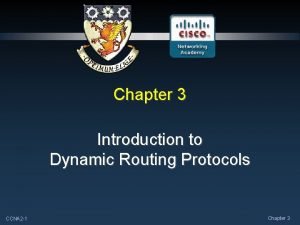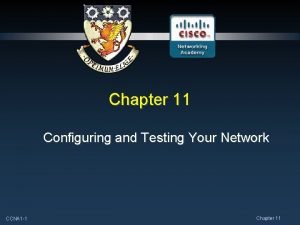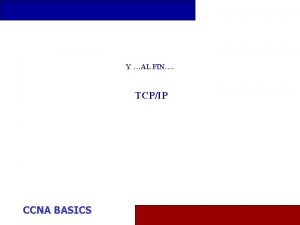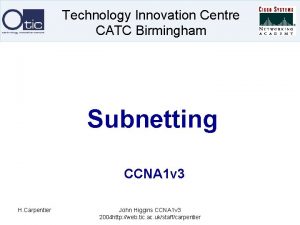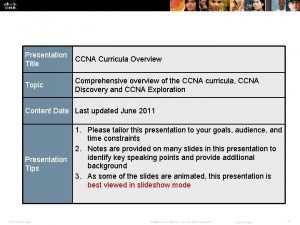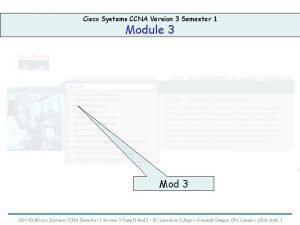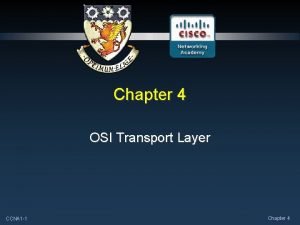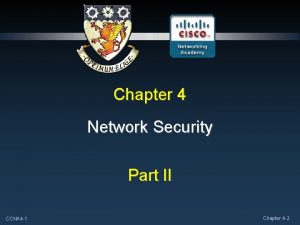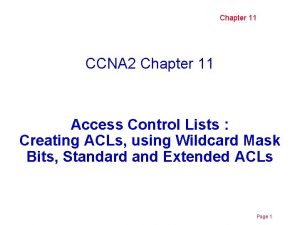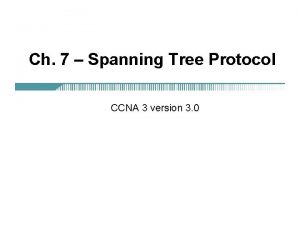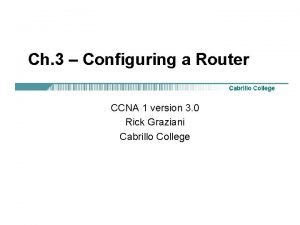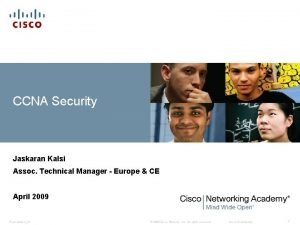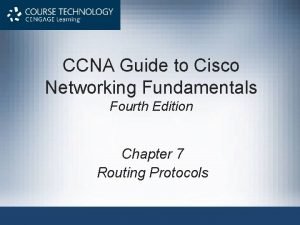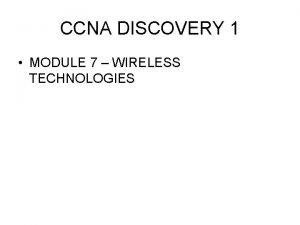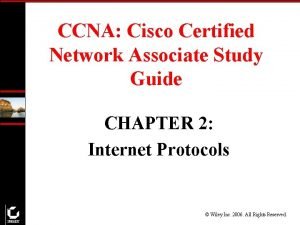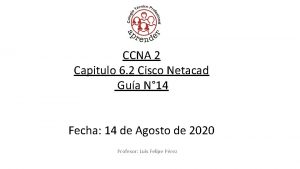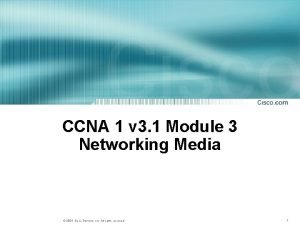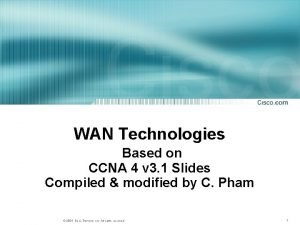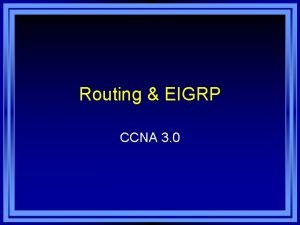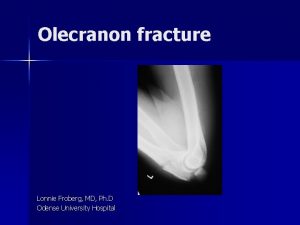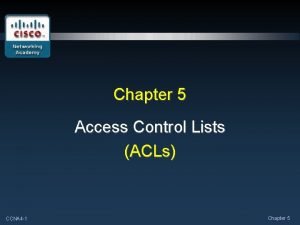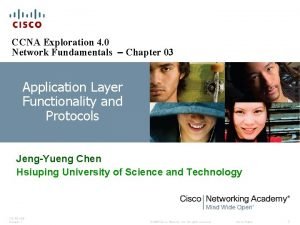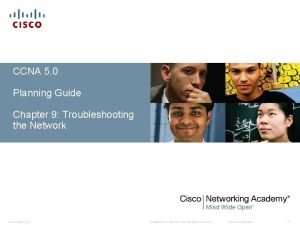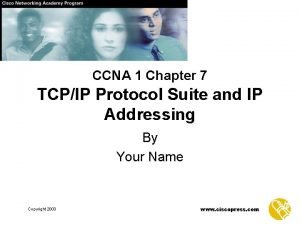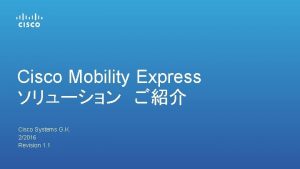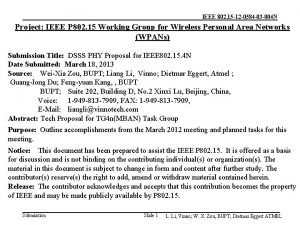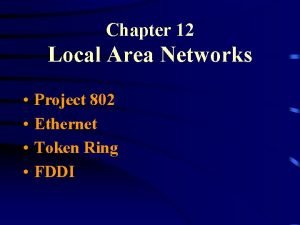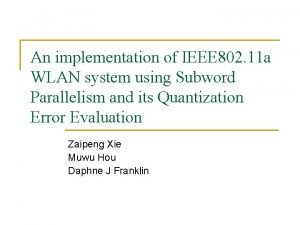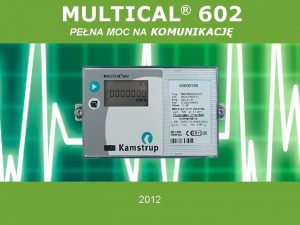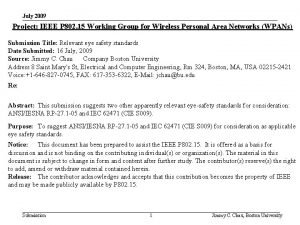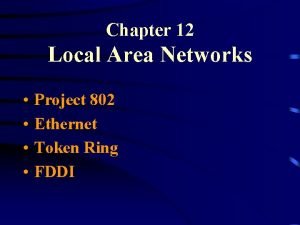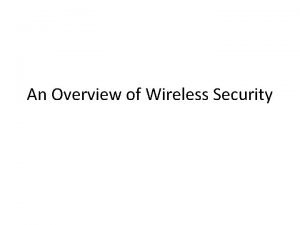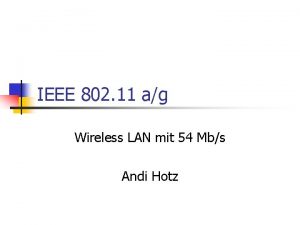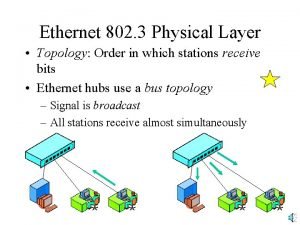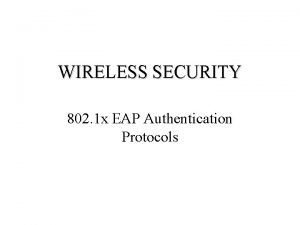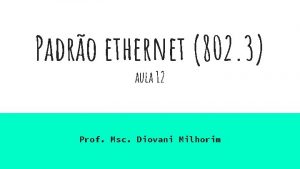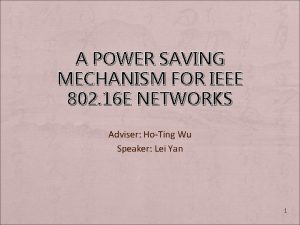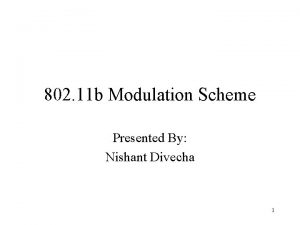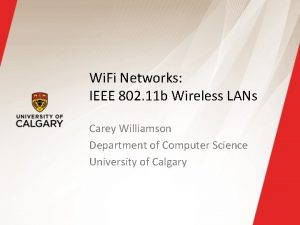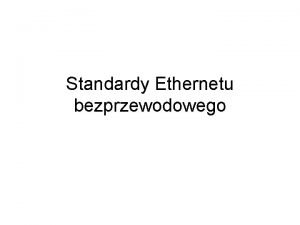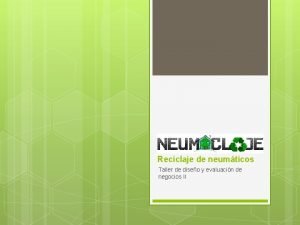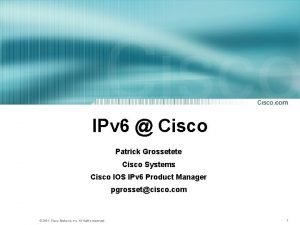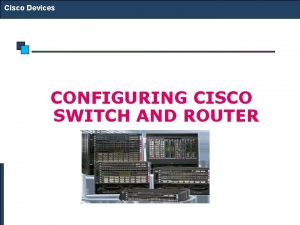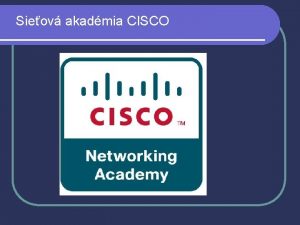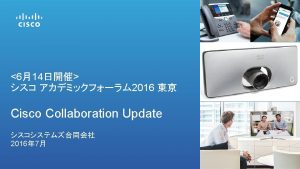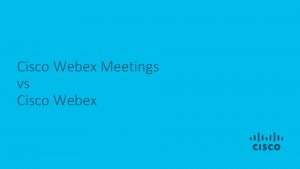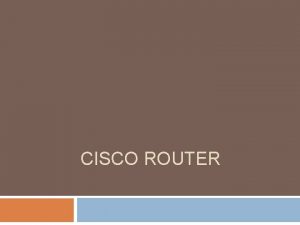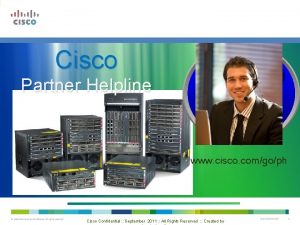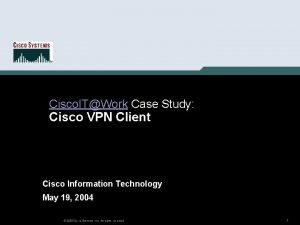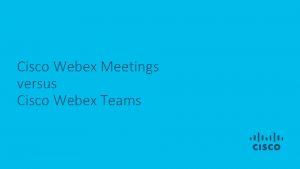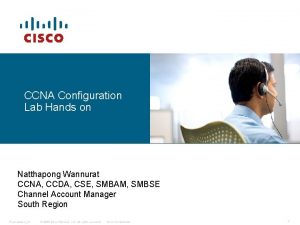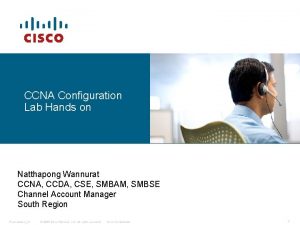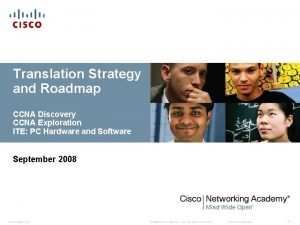802 11 Sep03 Cisco Systems CCNA Semester 1



















































































- Slides: 83

802. 11 Sep-03 ©Cisco Systems CCNA Semester 1 Version 3 Comp 11 Mod 2 – St. Lawrence College – Cornwall Campus – Clark slide 1

Sep-03 ©Cisco Systems CCNA Semester 1 Version 3 Comp 11 Mod 2 – St. Lawrence College – Cornwall Campus – Clark slide 2

IEEE 802 Committees 802. 0 SEC 802. 1 High Level Interface (HILI) 802. 2 Logical Link Control (LLC) 802. 3 CSMA/CD Working Group 802. 4 Token Bus IEEE 802. 11 a IEEE 802. 11 b Wi. Fi 802. 5 Token Ring 802. 6 Metropolitan Area Network (MAN) 802. 7 Broad. Band Technical Adv. Group (BBTAG) 802. 8 Fiber Optics Technical Adv. Group (FOTAG) 802. 9 Integrated Services LAN (ISLAN) 802. 10 Standard for Interoperable LAN Security (SILS) 801. 11 Wireless LAN (WLAN) IEEE 802. 11 g IEEE 802. 15. 1 Bluetooth IEEE 802. 11 e IEEE 802. 11 f IEEE 802. 11 h IEEE 802. 11 i Security 2004 802. 12 Demand Priority IEEE 802. 15 TG 2 802. 14 Cable-TV Based Broadband Communication Network IEEE 802. 15 TG 4 IEEE 802. 15 TG 3 802. 15 Wireless Personal Area Network (WPAN) 802. 16 Broadband Wireless Access (BBWA) RPRSG Resilient Packet Ring Study Group (RPRSG) Sep-03 ©Cisco Systems CCNA Semester 1 Version 3 Comp 11 Mod 2 – St. Lawrence College – Cornwall Campus – Clark slide 3

2. 4 GHz Radio Licenses NOT required in these bands 5 GHz Direct Sequence Spread Spectrum IEEE 802. 11 Standard for WLAN operations at data rates up to 2 Mbps in the 2. 4 GHz ISM band. DSSS modulation. IEEE 802. 11 a Standard for WLAN operations at data rates up to 54 Mbps in the 5 GHz band. Proprietary “rate doubling" has achieved 108 Mbps. Realistic rating is 20 -26 Mbps. IEEE 802. 11 b Wi-Fi™ or “high-speed wireless” 1, 2, 5. 5 and 11 Mbps in the 2. 4 GHz band. All 802. 11 b systems are backward compliant. Realistic rating is 2 to 4 Mbps. IEEE 802. 11 g 802. 11 a backward compatible to the 802. 11 b 2. 4 GHz band using OFDM. Orthogonal Frequency Division Multiplexing Sep-03 ©Cisco Systems CCNA Semester 1 Version 3 Comp 11 Mod 2 – St. Lawrence College – Cornwall Campus – Clark slide 4

Standard 802. 11 a 802. 11 b Data Rate ≤ 2 Mbps 2. 4 GHz ≤ 54 Mbps 5 GHz ≤ 11 Mbps 2. 4 GHz 802. 11 g ≤ 54 Mbps Bluetooth Up to 2 Mbps 2. 45 GHz 2. 4 GHz Modulation Scheme FHSS or DSSS Pros/Cons This specification has been extended into 802. 11 b. OFDM "Wi-Fi Certified. " 8 available channels. Less potential for RF interference than 802. 11 b and 802. 11 g. Better than 802. 11 b at supporting multimedia voice, video and largeimage applications in densely populated user environments. Relatively shorter range than 802. 11 b. Not interoperable with 802. 11 b. DSSS with CCK "Wi-Fi Certified. " 14 channels available. Not interoperable with 802. 11 a. Requires fewer access points than 802. 11 a for coverage of large areas. High-speed access to data at up to 300 feet from base station. OFDM > 20 Mbps DSSS + CCK < 20 Mbps "Wi-Fi Certified. " 14 channels available. May replace 802. 11 b. Improved security enhancements over 802. 11. Compatible with 802. 11 b. FHSS No native support for IP, so it does not support TCP/IP and wireless LAN applications well. Best suited for connecting PDAs, cell phones and PCs in short intervals. Adaptive Sep-03 ©Cisco Systems CCNA Semester 1 Version 3 Comp 11 Mod 2 – St. Lawrence College – Cornwall Campus – Clark slide 5

www. wi-fi. com Excellent Products listings Sep-03 ©Cisco Systems CCNA Semester 1 Version 3 Comp 11 Mod 2 – St. Lawrence College – Cornwall Campus – Clark slide 6

Sep-03 ©Cisco Systems CCNA Semester 1 Version 3 Comp 11 Mod 2 – St. Lawrence College – Cornwall Campus – Clark slide 7

20 -30% overlap Access Points (APs) 91. 44 to 152. 4 meters Sep-03 ©Cisco Systems CCNA Semester 1 Version 3 Comp 11 Mod 2 – St. Lawrence College – Cornwall Campus – Clark slide 8

Sep-03 ©Cisco Systems CCNA Semester 1 Version 3 Comp 11 Mod 2 – St. Lawrence College – Cornwall Campus – Clark slide 9

Sep-03 ©Cisco Systems CCNA Semester 1 Version 3 Comp 11 Mod 2 – St. Lawrence College – Cornwall Campus – Clark slide 10

Sep-03 ©Cisco Systems CCNA Semester 1 Version 3 Comp 11 Mod 2 – St. Lawrence College – Cornwall Campus – Clark slide 11

Sep-03 ©Cisco Systems CCNA Semester 1 Version 3 Comp 11 Mod 2 – St. Lawrence College – Cornwall Campus – Clark slide 12

D-Link - 22 Mbps 802. 11 b+ Wireless Router and PC Card Bundle (Refurbished) $49. 99 Sep-03 ©Cisco Systems CCNA Semester 1 Version 3 Comp 11 Mod 2 – St. Lawrence College – Cornwall Campus – Clark slide 13

When a source node sends a frame, the receiving node returns a positive acknowledgment (ACK). This can consume 50% of the available bandwidth. This overhead, combined with the collision avoidance protocol (CSMA/CA) reduces the actual data throughput to a maximum of 5. 0 to 5. 5 Mbps on an 802. 11 b wireless LAN rated at 11 Mbps. Sep-03 ©Cisco Systems CCNA Semester 1 Version 3 Comp 11 Mod 2 – St. Lawrence College – Cornwall Campus – Clark slide 14

802. 11 g Adaptive Sep-03 ©Cisco Systems CCNA Semester 1 Version 3 Comp 11 Mod 2 – St. Lawrence College – Cornwall Campus – Clark slide 15

802. 11 g Adaptive Sep-03 ©Cisco Systems CCNA Semester 1 Version 3 Comp 11 Mod 2 – St. Lawrence College – Cornwall Campus – Clark slide 16

802. 11 b Not Adaptive Sep-03 ©Cisco Systems CCNA Semester 1 Version 3 Comp 11 Mod 2 – St. Lawrence College – Cornwall Campus – Clark slide 17

The D-Link Air. Plus DWL-800 AP+ is an enhanced 802. 11 b Wireless Range Extender that can operate as an Wireless Access Point or Wireless Repeater. D-Link - DWL-800 AP+ - Enhanced Wireless 2. 4 GHz Range Extender $69. 99 Sep-03 ©Cisco Systems CCNA Semester 1 Version 3 Comp 11 Mod 2 – St. Lawrence College – Cornwall Campus – Clark slide 18

Sep-03 ©Cisco Systems CCNA Semester 1 Version 3 Comp 11 Mod 2 – St. Lawrence College – Cornwall Campus – Clark slide 19

Electromagnetic radiation Netgear - WGR 614 – Wireless 54 Mbps Cable/DSL Router "G“ $69. 99 Sep-03 ©Cisco Systems CCNA Semester 1 Version 3 Comp 11 Mod 2 – St. Lawrence College – Cornwall Campus – Clark slide 20

Electromagnetic Radiation Sep-03 ©Cisco Systems CCNA Semester 1 Version 3 Comp 11 Mod 2 – St. Lawrence College – Cornwall Campus – Clark slide 21

Electromagnetic Radiation In a transformer, the idea is to hold the energy inside a ferromagnetic material. If there is no ferromagnetic material, the energy will radiate. Sep-03 ©Cisco Systems Here the Tx (L 1) & Rx (L 2) coils are closely coupled. CCNA Semester 1 Version 3 Comp 11 Mod 2 – St. Lawrence College – Cornwall Campus – Clark slide 22

Electromagnetic Radiation Here the Tx & Rx coils … … are farther apart. And the induced voltage is less Sep-03 ©Cisco Systems CCNA Semester 1 Version 3 Comp 11 Mod 2 – St. Lawrence College – Cornwall Campus – Clark slide 23

Electromagnetic Radiation At some point they are no longer coils, they are ANTENNAS. And between them is an electromagnetic field. Sep-03 ©Cisco Systems CCNA Semester 1 Version 3 Comp 11 Mod 2 – St. Lawrence College – Cornwall Campus – Clark slide 24

Antenna Evolution Primitive coil antenna. Dipole antenna. Ground plane Dipole antenna. Floyd Sep-03 ©Cisco Systems CCNA Semester Version 3 Comp 11 Mod 2 – St. Lawrence College – Cornwall Campus – Clark slide 25 Electronics Fundamentals, Circuits, Devices and Applications, Fifth 1 Edition

Electromagnetic Radiation ½ Wave Length Dipole + Sep-03 ©Cisco Systems E H CCNA Semester 1 Version 3 Comp 11 Mod 2 – St. Lawrence College – Cornwall Campus – Clark slide 26

Electromagnetic Radiation An Electromagnetic wave carries the data stream between the Access Point and the Node. Sep-03 ©Cisco Systems CCNA Semester 1 Version 3 Comp 11 Mod 2 – St. Lawrence College – Cornwall Campus – Clark slide 27

Radiation Patterns Omni directional is used to cover an area. Sep-03 ©Cisco Systems CCNA Semester 1 Version 3 Comp 11 Mod 2 – St. Lawrence College – Cornwall Campus – Clark slide 28

• There are some applications where you do not want an omni directional pattern. • You want a directional pattern. Sep-03 ©Cisco Systems CCNA Semester 1 Version 3 Comp 11 Mod 2 – St. Lawrence College – Cornwall Campus – Clark slide 29

Adding extra elements will focus the pattern Reflector Element Active Dipole Yagi antenna 3 Directors Sep-03 ©Cisco Systems CCNA Semester 1 Version 3 Comp 11 Mod 2 – St. Lawrence College – Cornwall Campus – Clark slide 30

Making a parabolic antenna Then you can add a Parabolic Reflector to focus the pattern even more. Sep-03 ©Cisco Systems CCNA Semester 1 Version 3 Comp 11 Mod 2 – St. Lawrence College – Cornwall Campus – Clark slide 31

Parabolic antenna pattern 12 d. B yagi gain becomes 24 d. B for a 1 meter dish. Sep-03 ©Cisco Systems CCNA Semester 1 Version 3 Comp 11 Mod 2 – St. Lawrence College – Cornwall Campus – Clark slide 32

Various Antenna designs 6 d. B omni 2. 4 Ghz 6 d. B indoor omni 2. 4 Ghz 16 d. B Panel 2. 4 Ghz Sep-03 ©Cisco Systems 24 d. B solid dish 2. 4 Ghz CCNA Semester 1 Version 3 Comp 11 Mod 2 – St. Lawrence College – Cornwall Campus – Clark slide 33

Typical indoor directional WLAN antennas D-Link - DWL-R 60 AT Indoor 6 d. Bi Microstrip Antenna $34. 99 D-Link Ant 24 -0801 8. 5 DBI Pico Cell Patch Antenna $139. 99 Sep-03 ©Cisco Systems CCNA Semester 1 Version 3 Comp 11 Mod 2 – St. Lawrence College – Cornwall Campus – Clark slide 34

Most suppliers will have a complete family. Sep-03 ©Cisco Systems CCNA Semester 1 Version 3 Comp 11 Mod 2 – St. Lawrence College – Cornwall Campus – Clark slide 35

Outdoor Application. Sep-03 ©Cisco Systems CCNA Semester 1 Version 3 Comp 11 Mod 2 – St. Lawrence College – Cornwall Campus – Clark slide 36

Integrated Radio and Antenna – No gain flexibility Power over Ethernet Po. E Sep-03 ©Cisco Systems CCNA Semester 1 Version 3 Comp 11 Mod 2 – St. Lawrence College – Cornwall Campus – Clark slide 37

Sep-03 ©Cisco Systems CCNA Semester 1 Version 3 Comp 11 Mod 2 – St. Lawrence College – Cornwall Campus – Clark slide 38

Sep-03 ©Cisco Systems CCNA Semester 1 Version 3 Comp 11 Mod 2 – St. Lawrence College – Cornwall Campus – Clark slide 39

Integrated Radio and Antenna – No gain flexibility Po. E Sep-03 ©Cisco Systems CCNA Semester 1 Version 3 Comp 11 Mod 2 – St. Lawrence College – Cornwall Campus – Clark slide 40

Adaptive Sep-03 ©Cisco Systems CCNA Semester 1 Version 3 Comp 11 Mod 2 – St. Lawrence College – Cornwall Campus – Clark slide 41

Po. E Separate Hi gain antenna. Separate power amplifier. Sep-03 ©Cisco Systems CCNA Semester 1 Version 3 Comp 11 Mod 2 – St. Lawrence College – Cornwall Campus – Clark slide 42

Po. E Sep-03 ©Cisco Systems CCNA Semester 1 Version 3 Comp 11 Mod 2 – St. Lawrence College – Cornwall Campus – Clark slide 43

Sep-03 ©Cisco Systems CCNA Semester 1 Version 3 Comp 11 Mod 2 – St. Lawrence College – Cornwall Campus – Clark slide 44

Sep-03 ©Cisco Systems CCNA Semester 1 Version 3 Comp 11 Mod 2 – St. Lawrence College – Cornwall Campus – Clark slide 45

Sep-03 ©Cisco Systems CCNA Semester 1 Version 3 Comp 11 Mod 2 – St. Lawrence College – Cornwall Campus – Clark slide 46

Private Hot Spots Sep-03 ©Cisco Systems CCNA Semester 1 Version 3 Comp 11 Mod 2 – St. Lawrence College – Cornwall Campus – Clark slide 47

Public Hot Spots Sep-03 ©Cisco Systems CCNA Semester 1 Version 3 Comp 11 Mod 2 – St. Lawrence College – Cornwall Campus – Clark slide 48

Low speed Cell phone connections Sep-03 ©Cisco Systems CCNA Semester 1 Version 3 Comp 11 Mod 2 – St. Lawrence College – Cornwall Campus – Clark slide 49

Low speed Cell phone Availability Sep-03 ©Cisco Systems CCNA Semester 1 Version 3 Comp 11 Mod 2 – St. Lawrence College – Cornwall Campus – Clark slide 50

Modulation Schemes How does the bit stream become an electromagnetic wave ? The purpose of a radio is to convert a baseband signal (bit stream) into a modulated electromagnetic signal. A modulation scheme is selected that is appropriate for the particular electromagnetic spectrum. For Wireless LANs there are two main issues… • Interference • Multi-path distortion Sep-03 ©Cisco Systems CCNA Semester 1 Version 3 Comp 11 Mod 2 – St. Lawrence College – Cornwall Campus – Clark slide 51

Wireless Allocations in Canada This color means ‘Fixed Service’ 5 Ghz Band Sep-03 ©Cisco Systems 2. 4 Ghz Band CCNA Semester 1 Version 3 Comp 11 Mod 2 – St. Lawrence College – Cornwall Campus – Clark slide 52

5150 -5250 MHz, 5250 -5350 MHz and 5725 -5825 MHz. The band is shared with some pretty noisy services. Sep-03 ©Cisco Systems CCNA Semester 1 Version 3 Comp 11 Mod 2 – St. Lawrence College – Cornwall Campus – Clark slide 53

Sep-03 ©Cisco Systems CCNA Semester 1 Version 3 Comp 11 Mod 2 – St. Lawrence College – Cornwall Campus – Clark slide 54

The modulation scheme must tale this into consideration. Spectrum efficiency is NOT an issue. The use of the spectrum in the bands 5150 -5250 MHz, 5250 -5350 MHz and 5725 -5825 MHz for LE-LAN devices is on the basis that such devices cannot claim protection from other radio systems and cannot cause harmful interference into other radio services in these bands. 1 W transmitter output power; a power spectral density of 17 d. Bm in any 1 MHz band; a maximum 4 W EIRP; and fixed, pointto-point LE-LAN devices operating in this band may employ transmitting antennas with directional gain up to 23 d. Bi. Sep-03 ©Cisco Systems CCNA Semester 1 Version 3 Comp 11 Mod 2 – St. Lawrence College – Cornwall Campus – Clark slide 55

The 2. 4 Ghz Band is similar. Sep-03 ©Cisco Systems CCNA Semester 1 Version 3 Comp 11 Mod 2 – St. Lawrence College – Cornwall Campus – Clark slide 56

Then there is the problem of Multi-path distortion interference. Which will distort a nice clean pulse. Sep-03 ©Cisco Systems CCNA Semester 1 Version 3 Comp 11 Mod 2 – St. Lawrence College – Cornwall Campus – Clark slide 57

Standard 802. 11 a 802. 11 b Data Rate ≤ 2 Mbps 2. 4 GHz ≤ 54 Mbps 5 GHz ≤ 11 Mbps 2. 4 GHz 802. 11 g ≤ 54 Mbps Bluetooth Up to 2 Mbps 2. 45 GHz 2. 4 GHz Sep-03 ©Cisco Systems Modulation Scheme FHSS or DSSS Pros/Cons This specification has been extended into 802. 11 b. OFDM "Wi-Fi Certified. " 8 available channels. Less potential for RF interference than 802. 11 b and 802. 11 g. Better than 802. 11 b at supporting multimedia voice, video and largeimage applications in densely populated user environments. Relatively shorter range than 802. 11 b. Not interoperable with 802. 11 b. DSSS with CCK "Wi-Fi Certified. " 14 channels available. Not interoperable with 802. 11 a. Requires fewer access points than 802. 11 a for coverage of large areas. High-speed access to data at up to 300 feet from base station. OFDM > 20 Mbps DSSS + CCK < 20 Mbps "Wi-Fi Certified. " 14 channels available. May replace 802. 11 b. Improved security enhancements over 802. 11. Compatible with 802. 11 b. FHSS No native support for IP, so it does not support TCP/IP and wireless LAN applications well. Best suited for connecting PDAs, cell phones and PCs in short intervals. CCNA Semester 1 Version 3 Comp 11 Mod 2 – St. Lawrence College – Cornwall Campus – Clark slide 58

Spread Spectrum modulation schemes ease address problems, each in their own way. • DSSS Direct Sequence Spread Spectrum • OFDM Orthogonal Frequency Division Multiplexing • FHSS Frequency Hopping Spread Spectrum Sep-03 ©Cisco Systems CCNA Semester 1 Version 3 Comp 11 Mod 2 – St. Lawrence College – Cornwall Campus – Clark slide 59

• DSSS Direct Sequence Spread Spectrum The result is a string of chips. • In DSSS individual pulses are increased to a much higher frequency by multiplying them with a code that is unique to each WLAN. All the stations know the code. Sep-03 ©Cisco Systems CCNA Semester 1 Version 3 Comp 11 Mod 2 – St. Lawrence College – Cornwall Campus – Clark slide 60

• DSSS Direct Sequence Spread Spectrum Sep-03 ©Cisco Systems CCNA Semester 1 Version 3 Comp 11 Mod 2 – St. Lawrence College – Cornwall Campus – Clark slide 61

• DSSS Direct Sequence Spread Spectrum DSSS has good interference rejection. Sep-03 ©Cisco Systems CCNA Semester 1 Version 3 Comp 11 Mod 2 – St. Lawrence College – Cornwall Campus – Clark slide 62

OFDM Orthogonal Frequency Division Multiplexing Direct signal. Original reflected signal. Longer reflected signal. In OFDM, the reverse happens. 10 (say) serial bits are converted into 10 parallel bits, each of which modulates its own radio carrier. Each carrier is now carrying a bit rate that is 1/10 th the bit rate of the original. A reflected signal path needs to be 10 times longer to cause the same interference. Longer paths are more attenuated so the strength of the interference is also less. Sep-03 ©Cisco Systems CCNA Semester 1 Version 3 Comp 11 Mod 2 – St. Lawrence College – Cornwall Campus – Clark slide 63

OFDM Orthogonal Frequency Division Multiplexing. Where does orthogonal come from ? If the individual Radio Carriers are separated by exactly the bit rate… …then they will always be zero at the adjacent carrier frequency and there will be no interference between them. OFDM has good multi-path rejection. Sep-03 ©Cisco Systems CCNA Semester 1 Version 3 Comp 11 Mod 2 – St. Lawrence College – Cornwall Campus – Clark slide 64

FHSS Frequency Hopping Spread Spectrum FHSS also uses many frequencies, but only one at a time. The baseband jumps around very rapidly from one frequency to the next according to a predetermined pattern that is unique to each WLAN. Any interfering signal strong enough to cause an error will only affect the particular packet on that frequency. The transport layer would just resend that packet. Sep-03 ©Cisco Systems CCNA Semester 1 Version 3 Comp 11 Mod 2 – St. Lawrence College – Cornwall Campus – Clark slide 65

Layer 2 WLAN authentication occurs at Layer 2. It is the process of authenticating the device not the user. There three states…. Sep-03 ©Cisco Systems CCNA Semester 1 Version 3 Comp 11 Mod 2 – St. Lawrence College – Cornwall Campus – Clark slide 66

Layer 2 - Authentication Unauthenticated and unassociated The node is disconnected from the network and not associated to an access point. Authenticated and unassociated The node has been authenticated on the network but has not yet associated with the access point. Authenticated and associated The node is connected to the network and able to transmit and receive data through the access point. Sep-03 ©Cisco Systems CCNA Semester 1 Version 3 Comp 11 Mod 2 – St. Lawrence College – Cornwall Campus – Clark slide 67

Active scanning causes a probe request to be sent from the wireless node seeking to join the network. The probe request will contain the Service Set Identifier (SSID) of the network it wishes to join. When an AP with the same SSID is found, the AP will issue a probe response. Service Set Identifier (SSID) Sep-03 ©Cisco Systems CCNA Semester 1 Version 3 Comp 11 Mod 2 – St. Lawrence College – Cornwall Campus – Clark slide 68

Passive scanning nodes listen for beacon management frames (beacons), which are transmitted by the AP (infrastructure mode) or peer nodes (ad hoc). When a node receives a beacon that contains the SSID of the network it is trying to join, an attempt is made to join the network. Passive scanning is a continuous process and nodes may associate or disassociate with APs as signal strength changes. Service Set Identifier (SSID) Sep-03 ©Cisco Systems CCNA Semester 1 Version 3 Comp 11 Mod 2 – St. Lawrence College – Cornwall Campus – Clark slide 69

Authentication Open Authentication. This is an open connectivity standard in which only the SSID must match. This may be used in a secure or non-secure environment although the ability of low level network ‘sniffers’ to discover the SSID of the WLAN is high. Shared Key. This process requires the use of Wireless Equivalency Protocol (WEP) encryption. WEP is a fairly simple algorithm using 64 and 128 bit keys. The AP is configured with an encrypted key and nodes attempting to access the network through the AP must have a matching key. Statically assigned WEP keys provide a higher level of security than the open system but are definitely not hack proof. Wi-Fi Protected Access (WPA). Subset of 802. 11 i and backward compatible. Now mandatory for certification. Usually requires a server. Sep-03 ©Cisco Systems CCNA Semester 1 Version 3 Comp 11 Mod 2 – St. Lawrence College – Cornwall Campus – Clark slide 70

The payload of wireless and 802. 3 frames is 1500 bytes; however, an Ether frame may not exceed 1518 bytes whereas a wireless frame could be as large as 2346 bytes. Usually the WLAN frame size will be limited to 1518 bytes as it is most commonly connected to a wired Ethernet network. Sep-03 ©Cisco Systems CCNA Semester 1 Version 3 Comp 11 Mod 2 – St. Lawrence College – Cornwall Campus – Clark slide 71

WLAN Access The basic access method for 802. 11 is the Distributed Coordination Function (DCF) which uses Carrier Sense Multiple Access / Collision Avoidance (CSMA / CA). This requires each station to listen for other users. If the channel is idle, the station may transmit. However if it is busy, each station waits until transmission stops, and then enters into a random back off procedure. This prevents multiple stations from seizing the medium immediately after completion of the preceding transmission. – 61 % OH @ 54 Mbps link sending 512 byte data => ~ 21 Mbps useful. . SIFS Short Inter-Frame Spacing PIFS PCF Inter-Frame Spacing = SIFS + slot time DIFS DCF Inter-Frame Spacing = SIFS + 2*slot time Sep-03 ©Cisco Systems CCNA Semester 1 Version 3 Comp 11 Mod 2 – St. Lawrence College – Cornwall Campus – Clark slide 72

Sep-03 ©Cisco Systems CCNA Semester 1 Version 3 Comp 11 Mod 2 – St. Lawrence College – Cornwall Campus – Clark slide 73

The hidden node problem 1. 2. 3. 4. 5. 6. – 72 % OH @ 54 Mbps link sending 512 byte data => ~ 15 Mbps useful. Sep-03 ©Cisco Systems The station listens before it sends. If someone is already transmitting, wait for a random period and try again (as normal). If no one is transmitting then it sends a short message. This message is called the Ready To Send message (RTS). This message contains the destination address and the duration of the transmission. Other stations now know that they must wait that long before they can transmit. The destination then sends a short message which is the Clear To Send message (CTS). This message tells the source that it can send without fear of collisions. Each packet is acknowledged. If an acknowledgement is not received, the MAC layer retransmits the data. This entire sequence is called the 4 -way handshake as shown by figure 7 below. CCNA Semester 1 Version 3 Comp 11 Mod 2 – St. Lawrence College – Cornwall Campus – Clark slide 74

Sep-03 ©Cisco Systems CCNA Semester 1 Version 3 Comp 11 Mod 2 – St. Lawrence College – Cornwall Campus – Clark slide 75

VPN - Using an integrated server VPN technology creates a tunnel on top of an existing protocol such as IP. This is a Layer 3 connection as opposed to the Layer 2 connection between the AP and the sending node. EAP-MD 5 Challenge – Extensible Authentication Protocol is the earliest authentication type, which is very similar to CHAP password protection on a wired network. LEAP (Cisco) – Lightweight Extensible Authentication Protocol is the type primarily used on Cisco WLAN access points. LEAP provides security during credential exchange, encrypts using dynamic WEP keys, and supports mutual authentication. User authentication – Allows only authorized users to connect, send and receive data over the wireless network. Encryption – Provides encryption services further protecting the data from intruders. Data authentication – Ensures the integrity of the data, authenticating source and destination devices. Power over Ethernet - Support staff can disable a Po. E-enabled access point by shutting off its power after detecting a breach of security. Sep-03 ©Cisco Systems CCNA Semester 1 Version 3 Comp 11 Mod 2 – St. Lawrence College – Cornwall Campus – Clark slide 76

Wireless Security – Home users 1. Change the default SSID (network name). 2. Disable the SSID broadcast option. 3. Change the default password needed to access a wireless device. 4. Enable MAC address filtering. SSID (service set identifier) a 32 -character unique identifier attached to the header of packets sent over a WLAN that acts as a password when a mobile device tries to connect to the BSS. The SSID differentiates one WLAN from another, so all access points and all devices attempting to connect to a specific WLAN must use the same SSID. A device will not be permitted to join the BSS unless it can provide the unique SSID. Because an SSID can be sniffed in plain text from a packet it does not supply any security to the network. An SSID is also referred to as a network name because essentially it is a name that identifies a wireless network. Sep-03 ©Cisco Systems CCNA Semester 1 Version 3 Comp 11 Mod 2 – St. Lawrence College – Cornwall Campus – Clark slide 77

Sep-03 ©Cisco Systems CCNA Semester 1 Version 3 Comp 11 Mod 2 – St. Lawrence College – Cornwall Campus – Clark slide 78

Sep-03 ©Cisco Systems CCNA Semester 1 Version 3 Comp 11 Mod 2 – St. Lawrence College – Cornwall Campus – Clark slide 79

Sep-03 ©Cisco Systems CCNA Semester 1 Version 3 Comp 11 Mod 2 – St. Lawrence College – Cornwall Campus – Clark slide 80

Sep-03 ©Cisco Systems CCNA Semester 1 Version 3 Comp 11 Mod 2 – St. Lawrence College – Cornwall Campus – Clark slide 81

END Sep-03 ©Cisco Systems CCNA Semester 1 Version 3 Comp 11 Mod 2 – St. Lawrence College – Cornwall Campus – Clark slide 82

CCK • Short for Complementary Code Keying, a set of 64 eight-bit code words used to encode data for 5. 5 and 11 Mbps data rates in the 2. 4 GHz band of 802. 11 b wireless networking. • The code words have unique mathematical properties that allow them to be correctly distinguished from one another by a receiver even in the presence of substantial noise and multipath interference. • CCK works only in conjunction with the DSSS technology that is specified in the original 802. 11 standard. It does not work with FHSS. • CCK applies sophisticated mathematical formulas to the DSSS codes, permitting the codes to represent a greater volume of information per clock cycle. • The transmitter can then send multiple bits of information with each DSSS code, enough to make possible the 11 Mbps of data rather than the 2 Mbps in the original standard. Sep-03 ©Cisco Systems CCNA Semester 1 Version 3 Comp 11 Mod 2 – St. Lawrence College – Cornwall Campus – Clark slide 83
 Sybex ccna
Sybex ccna Bridges from 802.x to 802.y
Bridges from 802.x to 802.y Bridges from 802.x to 802.y
Bridges from 802.x to 802.y Cisco ccna exploration
Cisco ccna exploration Ccna
Ccna Ccna 7
Ccna 7 Ccna guide to cisco networking
Ccna guide to cisco networking Ccna drugs
Ccna drugs Ccna exploration
Ccna exploration Ccna 640
Ccna 640 Rip ccna
Rip ccna Ccna 3 chapter 1
Ccna 3 chapter 1 Ccna chapter 7
Ccna chapter 7 Ccna chapter 7
Ccna chapter 7 Ccna 4 chapter 4
Ccna 4 chapter 4 Modern network security
Modern network security Frame relay ccna
Frame relay ccna Ccna exploration network fundamentals
Ccna exploration network fundamentals Ccna module 1
Ccna module 1 Osi model ccna
Osi model ccna Ccna makerere university
Ccna makerere university Eigrp ccna
Eigrp ccna Ccna 4 chapter 1
Ccna 4 chapter 1 Ccna voice 640-461 pdf
Ccna voice 640-461 pdf Ccna exploration 4
Ccna exploration 4 Netacad cisco
Netacad cisco Netacad cisco
Netacad cisco Inter vlan routing教學
Inter vlan routing教學 Ccna 2 chapter 3
Ccna 2 chapter 3 Ccna chapter 11
Ccna chapter 11 Ccna 5
Ccna 5 Ccna 200-301 slides
Ccna 200-301 slides Ccna
Ccna Ccna birmingham
Ccna birmingham Ccna
Ccna 11mod3
11mod3 Expectational acknowledgement
Expectational acknowledgement Ccna 4 chapter 4
Ccna 4 chapter 4 Ccna chapter 11
Ccna chapter 11 Ccna
Ccna Ccna 200-301 ppt slides download
Ccna 200-301 ppt slides download Ccna
Ccna Ccna
Ccna Networking fundamentals
Networking fundamentals Ccna discovery 1
Ccna discovery 1 Ccna
Ccna Ccna module 3
Ccna module 3 Netacad
Netacad Ccna module 3
Ccna module 3 Wan technologies ccna
Wan technologies ccna Eigrp ccna
Eigrp ccna Troclear notch
Troclear notch Ccna 4 chapter 5
Ccna 4 chapter 5 Ccna exploration 4
Ccna exploration 4 Ccna5
Ccna5 Ccna 1 chapter 7
Ccna 1 chapter 7 Cisco mobility express wlc 違い
Cisco mobility express wlc 違い 802-11-iapp
802-11-iapp 802 15
802 15 802 ieee
802 ieee 802*12
802*12 Ieee 802 bluetooth
Ieee 802 bluetooth Wlan 802
Wlan 802 Geo 802
Geo 802 Multical 602
Multical 602 09 802 0561
09 802 0561 Project 802
Project 802 802-11-wireless-security
802-11-wireless-security 802 5
802 5 802 ieee
802 ieee Wireless lan 802
Wireless lan 802 Ethernet 802
Ethernet 802 802 eap
802 eap 802 3
802 3 Ieee 802 family
Ieee 802 family 802 16
802 16 802 11
802 11 Ssin-802
Ssin-802 802 11 b
802 11 b Ieee 802
Ieee 802 Standardy 802
Standardy 802 802 701
802 701 507-802-380
507-802-380 Ieee 802 standard
Ieee 802 standard



